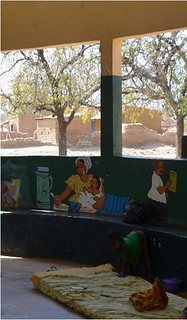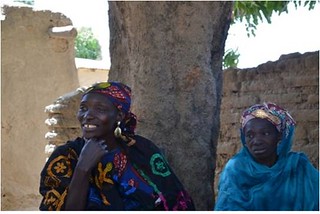Women ‘nutrition leaders’ changing the fate of children in Mali

‘We must take care of our babies even before they are born. It’s like when you want to have good cotton, you need to fertilize the soil to nourish the seeds for a good yield, says Assa Kayentoo using words that she knows her audience will relate to.
Kayentoo, a 46-year-old nutrition field school trainer, who works for the Malian NGO Amassa in Koutiala in Southern Mali, was among women who recently graduated from the Koulikoro Institute in Mali. She is also a rare example of a divorced financially independent woman bringing up two children on her own.
‘Less than a third of adult women in Mali are literate and I need to visually explain the facts about nutrition to the women I target in my work, says Kayentoo. ‘I tell them that proteins are like the bricks needed to build a house – without proteins a child won’t grow,’ she says.
Oral and visual nutrition education is followed by a communal cookery class. ‘This week’s menu is protein-rich peanut and amaranth sauce, iron and vitamin C-rich soumbala (made from nere seeds) and wholegrain sorghum porridge,’ she adds.

In the N’golobougou community health centre in the south of the country, a brightly painted wall shows a mother feeding her baby with porridge while the older sister in the background holds a school book. Fighting child malnutrition in the Sahel has always been a daunting task. In Southern Mali, over 28% of children under-five are stunted despite this being the grain basket of the country. Malnutrition is especially widespread among children in rural areas. Iron deficiency is a major cause of anaemia, which is particularly severe in this region.
Scaling up nutrition field schools
But things are changing. A leader at the community centre says that in January 2015 only 1% of the 6,145 children aged 0-5 years from N’golobougou and neighbouring villages suffered from severe and moderate acute malnutrition.
The centre says nutrition field schools which have been educating women on nutrition and changing cooking habits over the last couple of years are responsible for the improvement in children’s health.
Amassa and AMEDD are two of the local NGOs supporting these schools in Koutiala region, where teaching includes participatory cookery sessions with support from the Africa RISING project.
Nutrition field schools target young mothers and pregnant women many of whom are illiterate. This practical culinary approach was designed by Helen Keller International, Institut d’Economie Rurale (IER), the World Vegetable Center (AVRDC) and the International Crops Research Institute for the Semi-Arid Tropics (ICRISAT).
The real stars of the show however, are women like Kayentoo and the village nutrition leaders she trains who are chosen from the community for their leadership and child care skills and who later train others in village clusters.
Social stigma

A recently trained nutrition leader and mother of four, Aminata Sanogo, has sparked a cookery revolution in the family kitchen. She cooks Tô with whole grain sorghum which was previously unthinkable in a society where women are expected to incessantly pound perfectly decorticated sorghum grains (without the outer seed coat or bran) because women whose Tô has bran were seen as lazy.
Sanogo has been teaching women to cook sorghum and millet grains differently, such as using whole grain or mixing with it with protein-rich legumes like cowpea. So far 290 people have participated in nutrition field schools (94% women) and about 600 households have benefited from collective demonstrations. The consumption of whole grain sorghum increased from seven (baseline household consumption survey) to 96 in the six targeted villages.
Aminata and her husband are changing perceptions and helping break social stigma by showing that whole grain Tô is delicious and healthy. The nutrition value of whole-grain Tô is double that of Tô made when the bran is removed. Eating whole grain not only means better nutrition but also frees up time for women to do other things such as childcare.
Sorghum and millet, which are climate resilient cereals, are crucial staple foods in the rural Malian diet, providing three quarters of the total energy intake of mothers. Yet, while cereals provide about half of the iron intake and up to 75% of zinc intake, the total intake of these essential minerals for child health and development is far below international recommendations.
Could wholegrain be the way forward?
But simply keeping the bran isn’t the answer. Bran is rich in phytates, which are essential for germination and the main form of phosphorus in grain, but also inhibit the absorption of iron and zinc in the body (bioavailability). However, this bioavailability can be countered through food preparation methods like soaking the grain overnight before milling and by fortifying the food using locally available vitamin C-rich ingredients such as tamarind or baobab fruit, which significantly increase iron and zinc uptake. Data shows that these measures could help increase iron uptake in children by over 50%.
Sanogo’s also gives advice in other health matters. Women participating in these schools are more likely to practice exclusive breastfeeding, which increased from 20 to 89% and pregnant women increase their attendance at the health centre. Some women have also convinced their husbands to give them individual plots where they are now producing cowpea, groundnut and new sorghum varieties.
For Sanogo, this is just the start. Women from villages 10 kms away have asked for the same cookery sessions in their villages and despite not being paid, she says she will go and share her skills because it gives her maaya-juru, refertting to the boost in her social networks a highly-valued skills in Bambara culture. Training more women like Sanogo could be a turning point in mother and child nutrition in rural Mali.
Written by Jerome Bossuet. The original version of this story was published in the ICRISAT Happenings Bulletin on 6 March 2015




